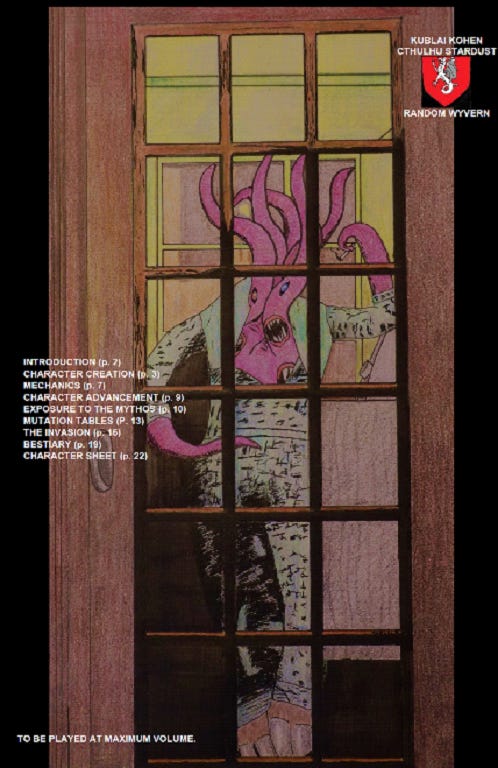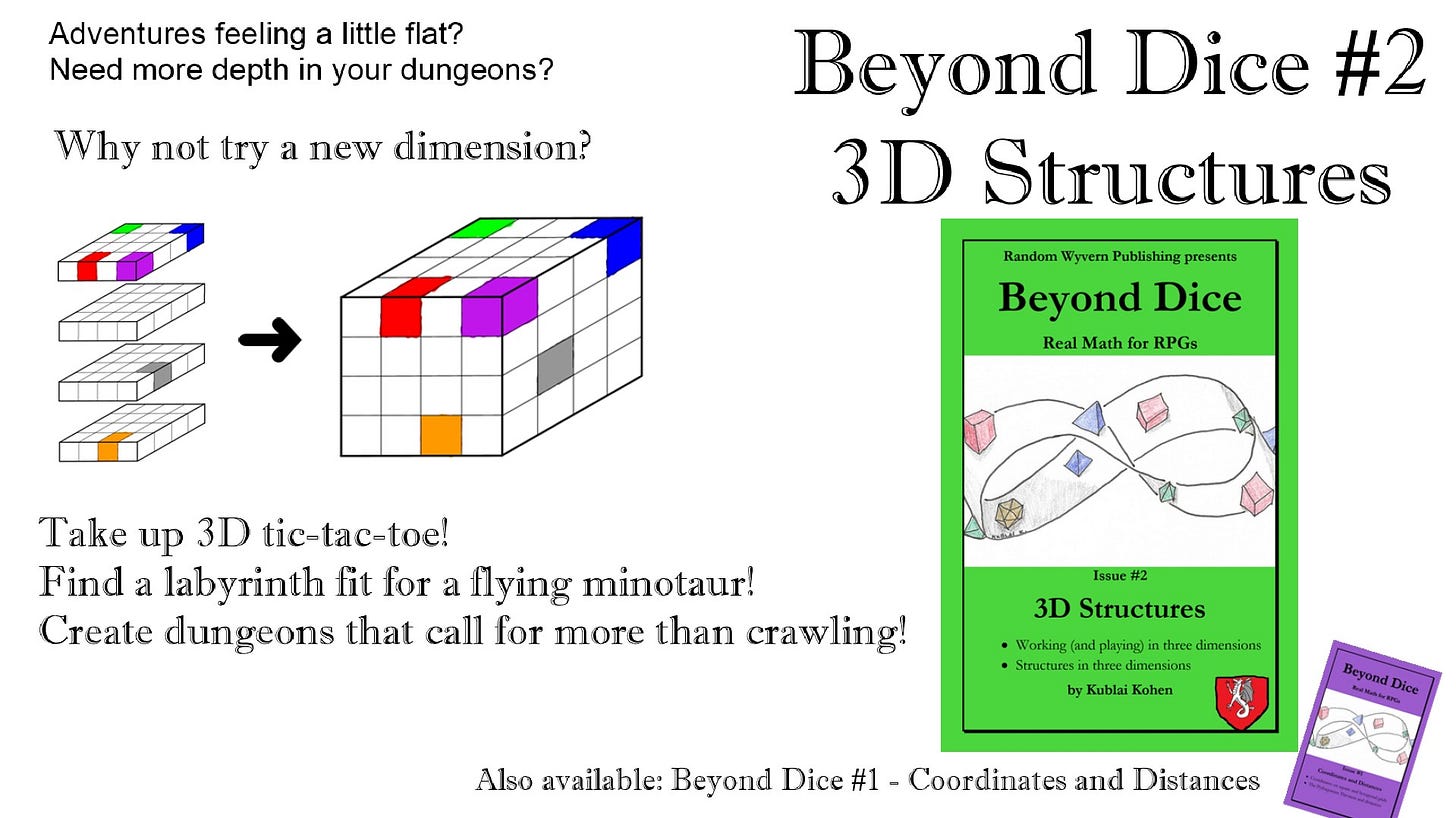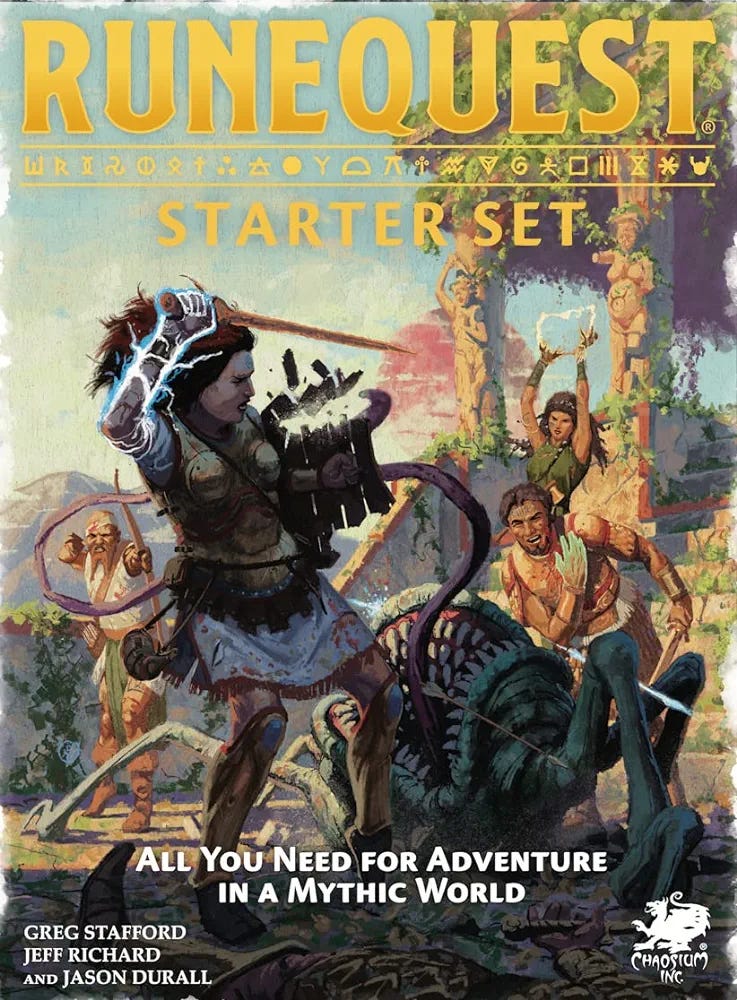Watch Well Games: Issue #26
David Bowie meets Lovecraft. Exclusive offer on custom dice bags. And more!
Welcome to our RPG community newsletter!
Here's what we've got for you today:
Special guest writer Kublai Kohen’s shares how you can make an RPG where David Bowie meets Lovecraft. Read his design essay to see what I mean.
In addition, Kublai’s newest issue of Beyond Dice just dropped. You can grab a copy at 20% off the regular price.
In search of new wares - specifically, quality handmade dice bags? I have a keen recommendation - and a special discount code - just for YOU!
Hail, all Traveller, RuneQuest, and Call of Cthulhu fans. My friend Warren Davidson (Wazza) returns to share about these three RPGs’ starter sets.
I’m K.J. If you’d like to learn more about me, click that lil’ green button below.
I’m on Hiatus
My two series (Accounts of Adventure and “Make a game with me”) are on break this week so I can allot more room for others. Watch Well Games is about community. It’s literally in the slogan I came up with for WWG:
“Creating community. Sharing stories.”
These contributors and creators are well worth that extra space.
When I return with my own projects and writings, I will have some (hopefully) exciting things to share. Be sure to refer this substack to your friends so they don’t miss out.
Light in Darkness Gaming: Preparing for Patreon Launch
Schlau has been working diligently on setting up his Patreon. Because of this, he doesn’t have a free map for you this week. You can, however, still download all his previously released free maps. Just use the Dropbox link below.
Watch this space for a special announcement regarding the Patreon release!
15% Off Dice & Hobby Bags from Beverleyinstitches



In a future newsletter, I will do a video review of my own dicebag from Beverleyinstitches - a special Etsy store (a Star Seller with outstanding reviews). In the meantime, readers can enjoy an exclusive discount of 15% off. Just use the code WATCHWELL15 when placing your order.
You can even share this code with friends and family who want their own dice bags from the shop!
BONUS: If you order from Beverley’s Etsy shop, let me know. I’ll send you a special gift on top of that at no extra cost. (Proof of purchase required.)
Inventory may be a bit low due to demand, so if items sell out, simply “follow” the shop on Etsy to get notified when Beverley has new dice bags ready.
Don’t see one that quite fits your taste? No problem!
Beverley accepts custom requests for orders, so if there’s a particular fabric, pattern, or design you’d prefer, use the contact form on her Etsy shop to begin a conversation on the possibilities.
Fun with Juxpastosi.. Juxapoti… Juxtapoti… Fun with Putting Weird Things Together
by guest writer Kublai Kohen
Note from K.J.: Kublai is a Pocket Quest peer who is both funny and brilliant. Don’t take my word for it. Read his design essay here and then check out his newest issue of Beyond Dice (see the ad at the end of this article).
I had a brilliant teacher for Grade 10 English. He was funny and witty, he cared about us, he dispensed cantankerous wisdom, we were deeply invested in the budding romance between him and the kindergarten teacher across the hall… In class, we covered some excellent literature in his class, but what I remember best are the lessons in literary terms. To be clear, I am not the kind of nerd that would recall the first time someone distinguished iambic metre from trochaic (mind you, I am a whole ‘nother type of nerd), but learning the word juxtaposition was a revelation. A juxtaposition just means putting two things next to each other. According to my teacher, the term is used in literary studies to describe the putting of two separate things together to have each reflect on the other. In this article, I will walk through the design of one of my games to show how to create interesting games and adventures by placing together a couple of unrelated ideas.
Writers often use juxtaposition in their work, whether with small phrases (“parting is such sweet sorrow” in Romeo and Juliet) or in the structure of an entire work. Stephen R. Donaldson has an excellent post-script in The Real Story (the first novel in the brilliant-but-brutal Gap Cycle) in which he talks about how he constructs stories. He says that he always takes two ideas – one familiar and one exotic – and meshes them together to see what will happen.
I think that using two main influences is the key here. Many stories try to take only one concept and then manipulate it in a variety of small ways. This can work very well, but it can also easily look like slavish imitation or poor fan fiction. Others try to twist together strands from multiple sources and often end up with an unwieldy mess. With only two ideas behind the work, there is a great amount of room for creativity and novelty, while maintaining a solid and reliable structure. This makes the creative process easier, while also helping it stay consistent in the long haul.
Coming up with the idea
Everything I have written for RPGs seems to follow this idea of juxtaposition. The prime example is the game I created for PocketQuest 2023. I had missed the announcement for the game jam and only found out about it at the halfway point. I decided that I would take one day to try to come up with an idea. If nothing came to me, then I would skip the event and wait until the following year.
The next morning, I was on the bus to work and thinking about the theme for the game jam – Space. I was still in the early phases, just going over what I might know well enough to use in creating a game. Nothing stood out for the first few minutes and then an image popped into my head. It was the cover for David Bowie’s Aladdin Sane album – Bowie, nearly as pale as the white background, with a shock of red hair, and his eyes closed reverently, a read-and-blue lightning bolt of makeup on his face – except with Cthulhu standing in for Bowie. Here was the literal bolt of inspiration. I’ve been a fan of both H.P. Lovecraft and David Bowie for many years, and this seemed a perfect combination.
To begin, I wanted to choose one of the elements as the primary source for the game – it would be the thing to which I would add the other element. The Cthulhu mythos, even if we stay with just the Lovecraft stories, has many separate stories, is often complex, and can contradict itself. On the other hand, Bowie has The Rise and Fall of Ziggy Stardust and the Spiders from Mars, an entire concept album about a spaceman coming to Earth to give us hope before apocalypse strikes. It’s a single story, it deals with space, has wild imagery, and is not so detailed that I would get lost in the specifics. So, I opted to use Bowie’s album as the spine of the worldbuilding. The first twist was obvious – the spaceman would not be bringing hope. It would be Cthulhu, coming down from the sky to take over the Earth. The spaceman was the apocalypse. And so I had my title: The Rise and Triumph of Cthulhu Stardust and the Leng Spiders from Mars.
Casting Cthulhu as the spaceman and the apocalypse was a perfect fit. On the one hand, the story in the album took Cthulhu into space. On the other, the spaceman of the album became a source of death rather than hope. Already my two inspirations were twisting around each other.
Creating the story
Instinctively, I stuck close to Bowie’s storyline at first, but loosened my grip on it as the process continued. I have the kind of mind that enjoys technical challenges and I was (probably rightly) afraid that I would let some very formal and arbitrary rule determine how I would combine the elements of my game and that this would lead to something that is not fun at all. So, I started with the opening track of the album, “Five Years,” and tried to adapt it directly. There isn’t much plot here – the news of the coming apocalypse has everyone in shock and some handle the news much worse than others. The opening talks of the newsman crying on TV. I took the image and put a horror spin on it, but I also decided that I wanted the game to have a bit of a longer buildup. Instead of everyone realizing that the world was coming to an end, it would only be a few people who start to realize what is happening and will try to warn the rest. Again, the two elements inform each other, as we combine Bowie’s scenes with Lovecraftian details.
The next major song in the album is “Starman,” in which a teenager and his friend stumble onto the frequency at which a visitor to Earth is broadcasting a message of hope. It is a bit of a Pandora’s box story and I did not want to let the game go from dark to grim. At least, not yet. I tried to figure out a way for the presence of the Mythos to provide some advantages. This took a bit of time but became my favourite mechanism in the game. In Call of Cthulhu and many of the games based on it, witnessing the otherworldly eats away at a person’s sanity. Instead, I decided to make the effect more substantive. Exposure to the Mythos mutates the characters, giving them greater powers, but also eating away at their humanity and driving them to betray their friends until they lose all control of their actions.
These early decisions were enough to start putting in details. We know that Cthulhu sleeps in the city of R’lyeh. We know that Ziggy Stardust comes from Mars. So, I placed R’yleh on Mars and had Cthulhu and a couple of his mates waking up from there and starting a slow invasion of our world, which explains the five years we have before the end. This led to dividing the story into three sections – the early years of trying to find evidence of the coming invasion, the fight against the invasion itself, and survival after the inevitable loss. Each of these sections was titled after a song from the album and had some of its elements.
Finishing the game
Once I had the major components, the story and the game mechanics started to take care of themselves. Much of the story wrote itself, and there were large sections that did not require going back to either source material. Deciding not to stick too close paid off nicely, and at this stage I was free to focus on what was best for the story and the game, while keeping an eye out for useful connections to either Ziggy or the Mythos.
I used Lovecraft directly for the game’s bestiary – the strange nightgaunts make an appearance – but kept returning to snippets of Bowie lyrics for things they were never meant to describe. “[She] just put my spine out of place” turned into a description of nightgaunts snapping someone’s spine in two. The final moment of the middle era of the story was an image that came from a Bowie line, but by the time the Mythos element was brought in, I don’t think anyone would recognize the source anymore.
Finally, I also had some fun with the game. I find that a bit of humour helps horror hit home a little harder. There were various small references that were done in a more playful way. Even so, these Easter eggs only served to make the game more consistent within itself and with its sources. My favourite was the back cover of the game. It’s a play on the back cover of the Bowie album, but with Shub-Niggurath squeezing its tentacled body into a neon-green jumpsuit and stylishly smoking a cigarette in a phone booth. The table of contents is there, instead of the song listing, but I kept the final, brilliant instruction from the album: “To be played at maximum volume.”
I hope this helps you with designing your next game or adventure. I have done something like this in each Pocket Quest – there is a mashup of this game with that of others who wrote a game last year (we already wrote a design essay for CATastrophe on Stardust 7 in a previous newsletter), and there is a game that takes the gravitas and game mechanics of Ironsworn and places them in the carefree world of summer camp. Play around with juxtapositions and see what you form in your mind.
Kublai Kohen’s newest issue of Beyond Dice just released on DriveThruRPG. Use the link below to enjoy 20% until June 21st:
Find all of Kublai Kohen’s games and supplements on DriveThruRPG:
Wazza’s Whimsical Wanderings Part Two - Starships and Mythos and Runes, Oh My!
by guest writer Warren Davidson
In the beginning, there was D&D, and it was a monumental success. 50 years later it’s still the most successful role-playing game on the market and it makes sense for beginning GMs to run it to improve your skills and experience. In time you might want to try something different. Perhaps you prefer science-fiction or horror, or maybe you feel D&D isn’t your thing. Fear not! There are countless alternatives available.
Here are three which have been around since the beginning of the hobby and are pioneers in their genre: Traveller, Call of Cthulhu and RuneQuest. All of them have been though several editions, rules and backgrounds. I shall be covering the latest iteration of each game and the pros and cons of running them as a beginner GM.
There were no science-fiction RPGs before Traveller, and when it appeared in 1977, it made quite the splash. It incorporated an elegant rules system, comprehensive character generation and rules for spaceships, robots, aliens, and it detailed a vast interstellar empire known as the third imperium of man. Traveller can accommodate any setting you can imagine from cyberpunk, hard sci-fi, space opera, near future to the far future. It offers a vast cornucopia of technology from weapons to computers and starships.
Fancy a merchant campaign where you travel from planet to planet selling your wares? Traveller has you covered.
How about playing hard-bitten Mercenaries or Scouts exploring the far reaches of the galaxy? No problem.
Of course, with such diversity comes its own problems, namely being overwhelmed with what to use and exclude.
My advice?
Start small and work your way up.
Choose a planet, give the PCs a ship and a patron who dolls out missions so they can pay off the exorbitant mortgage on it.
Vary the missions from exploration to military operations to buying and selling goods (including contraband) and you’ll have the foundation of a great campaign.
Have them encounter pirates, smugglers, diplomats and aliens.
Character generation is fun, and the system uses 2D6 for skill resolution and combat. Traveller doesn’t have classes or levels; rather you serve consecutive four-year terms of service in numerous professions to acquire and improve your skills. There are plenty of adventures and supplements available although all you need is the Traveller Core Rulebook Update 2022 and some D6’s. The current edition is by Mongoose Publishing so check out their website here:
Arguably the most popular horror role-playing game is Call of Cthulhu by Chaosium Inc. First published in 1981, it was an instant classic. Based on the stories of American horror writer H.P. Lovecraft, it blended the evocative setting of 1920s America with otherworldly mind-shattering cosmic horror. You play ordinary people investigating the plots of the Cthulhu Mythos, Gods, and monsters with unfathomable evil intent acting through their insane cultists to reclaim our planet. In this game you can expect your characters to be driven incurably insane and die hideously on a regular basis. Most monsters cannot be killed directly. Instead, you must you apply your wits and learn arcane knowledge to combat them which invariably drives you insane.
The rules system is percentage based and brings with it the infamous Sanity system, where your mind is eroded by exposure to the multitude of horrors you encounter during your investigations. Lose a few points of Sanity and go temporarily insane; lose the lot and you’ll spend the rest of your life in a sanatorium. It’s a brilliant and original concept. Combat is fast and deadly - backed by a comprehensive skills system. Hundreds of scenarios and supplements have been released, allowing you to set the game in any time era. There is more background to learn in this game, and it might not be to everyone’s taste if you dislike frequent character deaths. A brilliant starter set includes rules, several investigations, pre-generated character sheets and dice a great introduction to the game available here:
RuneQuest was the next fantasy role-playing after D&D, released by Chaosium Inc. in 1978. It uses an elegant percentage-based system for combat and skill resolution. The strength of RuneQuest is undoubtably its setting and attention to background detail, set in the mythical bronze age world of Glorantha, where characters hail from various cultural backgrounds and belong to religious cults, all of them richly and evocatively detailed. Unlike D&D there are no classes or levels, and every character can use magic. The game has a great sense of humour too, allowing you to play intelligent Ducks and fight chaos-spawned monsters such as the Pumpkin-headed Jack O’Bears and the Octopus-headed Waktapus. Combat is swift and deadly where lethal critical hits can instantly kill you, and fumbles punish the unlucky. Armour reduces damage and a realistic combat system lets you dodge and parry attacks. Mystical building blocks known as Runes shape your destiny and personality as much as your background and religion do. The system has similar statistics to D&D with the inclusion of Size (SIZ) and Power (POW). Hits points are a set amount with POW determining how many spells you can cast. The game is more complicated than D&D but in a good way. The starter set is one of the best around and is available here:
Warren Davidson’s perspective on the history of ttRPGs comes from playing the games since the early 1980s. Here’s the 3-part series published in previous newsletters:
That’s all for now, folks. Remember:
Support game creators by purchasing, playing, and positively reviewing the games (assuming you enjoyed them!).
Newsletters are free.
Ice is frozen water.















